FOR over three thousand years most Bible literalists believed that the Great Flood covered the entire planet, and above Mount Everest by 15 cubits (about 5 stories), and this is what the Bible said.
But the Bible doesn't actually "say" that.
The Book of Genesis said that the LORD saw that "mankind" had become wicked, so He sent a flood to kill "all living things" upon the "earth" (Hebrew: cultivated land).
EARTH=ERETZ
Bible literalists has assumed that "earth" meant the planet Earth, but this is a mistake. The ancients had no concept of a "planet". The word translated "earth" in English bibles comes from the Hebrew word "eretz" and simply means "the cultivated land". It does not refer to the desert nor the ocean nor "bad lands" where nothing grows. It means "cultivated land"; meaning land that that is used to grow things by the hand of man.
MANKIND=ADAMITES
Also, the ancient Hebrews (like all ancient peoples) did not consider all human beings to be "men" and members of "mankind". The term "mankind" from the Hebrew is ADOMAI and refers specifically to the descendants of Adam. In the Jewish Talmud, "man" is referred only as Jews and other Israelites; not to the "goiiym" (nations).
Even the British and Portuguese did not refer to non-Europeans as "men". The American Indians were "savages" and the black Africans were "negroes". When it says in the U.S. Constitution "all men are created equal" the authors were referring to white men only, and would probably laughed at you if you told them they were referring to the entire human species. The ancients thought the same. The Egyptians believed they were "men" but their term for "men" did not apply to other nations.
ARARAT=URARTU
Another false assumption by Bible literalists is that the Bible says that Noah's ark landed on Mount Ararat, in Turkey; a mountain over 14,000 feet high that is 14,000 high and is covered by slow-moving glaciers.
The Bible does NOT say that!
The Bible says that the Ark "rested" on "the mountains of RRT". The original Hebrew Bible had no vowels. All words were written in consonants only. The original Hebrew Bible says that the Ark "rested" on "the mountains of RRT."
When the Hebrew Bible was first translated into Greek, about 200 B.C., the Greek-speaking Jews did not know what RRT meant. So, they filled in the words with the letter "A" which made RRT into ARARAT.
In 200 B.C., there was no place on earth, no mountain on Earth, called "ARARAT". It simply did not exist. A Jewish scribe made up the name; because he did not know what RRT stood for! It is simply as that.
The mountain known today as "Mount Ararat" was not called that until the 8th century A.D.; long after the flood, and 1000 years after the Greek-speaking Jewish scribe in Alexandria, Egypt, invented the name "Ararat".
What we in the West call "Mount Ararat" was NEVER called that by the people who live near it. The Turks refer to it as Agri Dagh ("Painful Mountain"). The Armenians (who have lived in the area much longer than the Turks) call it "Agiri ?????" ("Fiery Mountain"); based upon the fact that it erupted tens of thousands of years ago, and the local people still have an oral tradition that it spit out fire.

Agri Dagh (Mount Ararat)
The mountain was NEVER known as "Mount Ararat"! It was only called such by Greek monks in the 8th century A.D.; based upon a FALSE belief that this was the mountain that Noah's Ark landed on and the mistranslation of a Greek-speaking Jewish scribe who lived in Alexandria Egypt in the 2nd century B.C. who MIStranslated "mountains of Urartu" into "the mountain of Ararat".
Bible scholars know today what RRT stood for. It stood for URARTU; an ancient Kingdom that included present day Armenia, and parks of eastern Turkley, Georgia, Azerbaijan, and Iran. The name URARTU is an ancient Assyrian word meaning "Lava flows". The ancient Kingdom of Urartu has many lava flows because it is a land of many ancient volcanoes.
The Kingdom of Urartu was a very mountainous region:
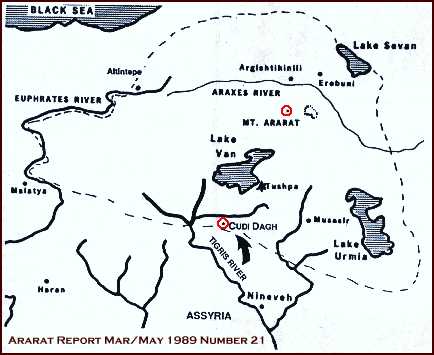

Within the Kingdom of Urartu were the head-waters of four great rivers:
The Euphrates
The Tigris
The Zab
The Araxes
Some Bible scholars think these are the four Rivers mentioned in Genesis.
The Urartuians spoke a language closely related to Sumerian. Today, the people who live in this area speak Turkish, Azerbaijani, Armenian, Kurdish, and Farsi.
NUKKHTCH=NOAH
Does this area have any "oral history" regarding Noah and the Flood?
It does! According to ancient oral history, a man named Nukkhtch and his family lived in the Valley of Urartu (Ararat). The Valley of Ararat is a large fertile valley about 100 miles long which is currently divided between Armenia, Turkey, Azerbaijan, and Iran.
Nukkhtch was a wine-grower, and even today the Valley of Ararat is known for its amazing wines. Here are a few photos of the Valley:
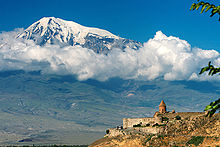
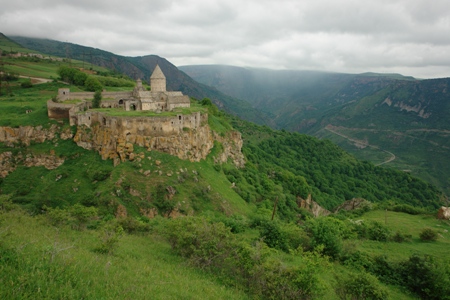
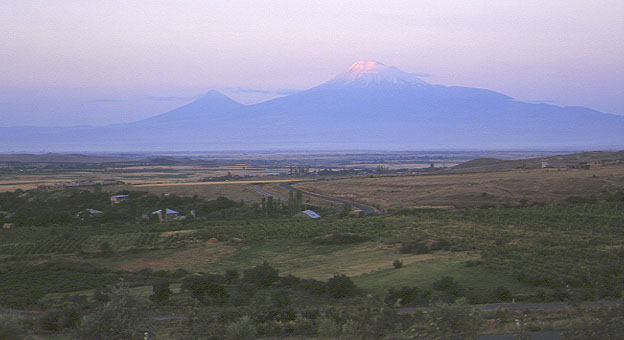
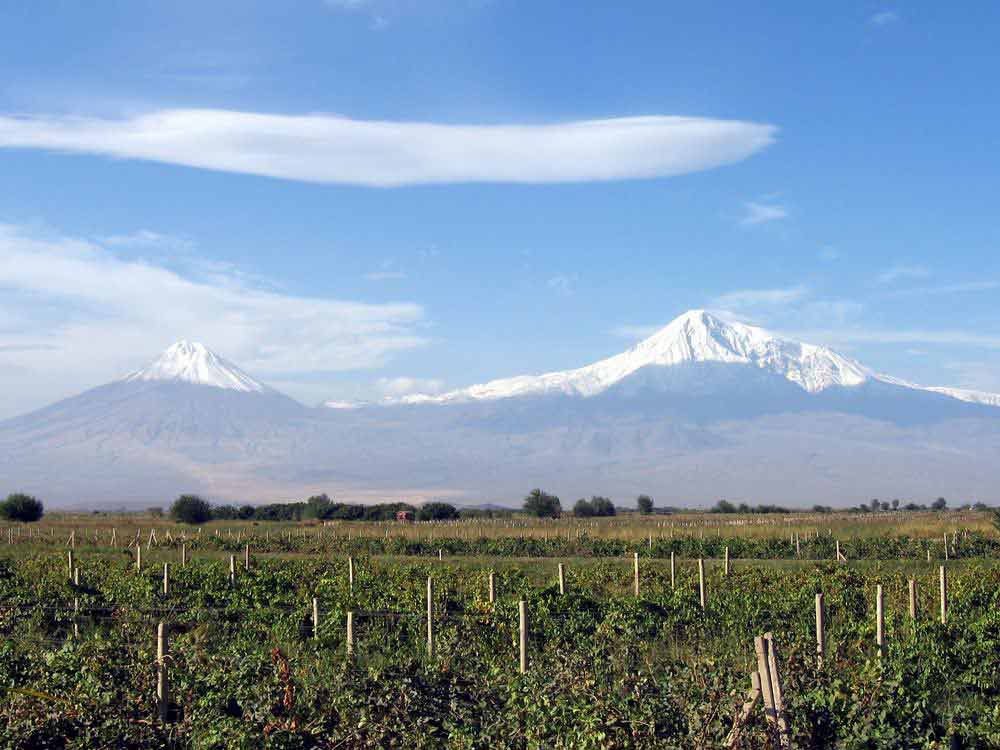
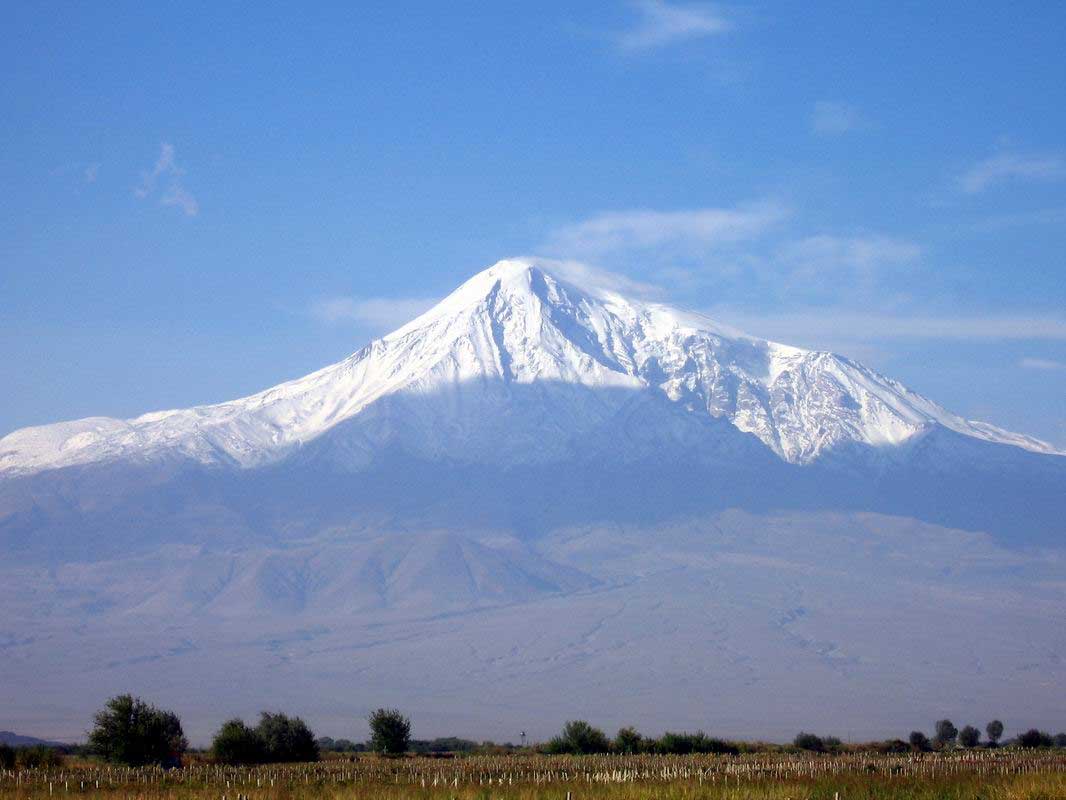
The Valley is perfect for growing grapes; which is probably why Noah is referred to in the Book of Genesis as a "husbandman" (wine-maker).

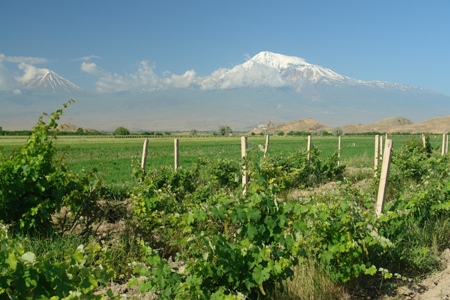
The Valley is known for its vineyards
According to the ancient oral legend, there was indeed "many days and nights" of intensive rain, and a flood filled the valley and killed everyone who lived in the valley. Only Nukkhtch and his family and the animals they brought with them were spared.
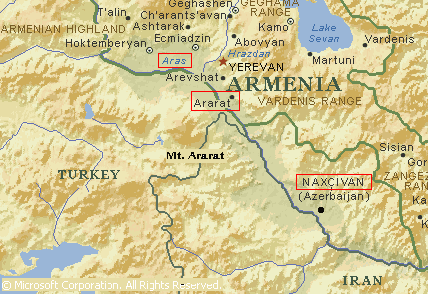
The light green shading shows the Valley of Ararat. It is a "basin". The river Aras (Araxes) runs through it and on the southern end via a very narrow gorge that is subject to mud-avalanches when it rains hard (which it seldom does); thus blocking the outflow of water. The southern park of valley is the Autonomous Province of NAXCIVAN which is part of Azerbaijan. The original name of this area was NAKHITCH-EVAN ("Noah's Colony").
According to local legend, Noah entered the Ark at present day Nakhitchevan; which is a city that overlooks the Valley and the River Arax (Araxes) just before the river enters the narrow gorge.

City of Nakhchivan (Noah's Colony)
The Valley of Ararat is like a huge bowel! The only thing that takes the water away is the River Araxes, but the river must pass through a very narrow gorge that leads from the Valley. If for any reason the gorge is closed (say by mud or a natural damn caused by a huge flood), then the Valley of Ararat fills up like a bowel; with no place for the water to go.
2800 B.C.=COMET HIT
Bible chronology places the Flood of Noah about 2800 B.C. Coincidentally, about 2800 B.C. we know the following happen:
*A huge comet hit the Indian Ocean; sending trillions of tons of water-vapor into the upper atmosphere and sending huge tsumanis into Madagascar and Western Australia.
*About 2800 B.C. hundreds of thousands of mammoths in Siberia froze to death within a few hours; preserving their bodies and stomachs; most of which had huge amounts of grass and flowers in them.
*About 2800 B.C. the "Ice Man" was frozen and buried by freakish snows in the Alps; his body recovered only in the last 10 years.
*About 2800 B.C. the Earth experienced a "mini-ice-age" which lasted about 1000 years.
*About 2800 B.C. the cities of ancient Mesopotamia (Iraq) were flooded when the Euphrates and Tigris went up about 15 cubits beyond their normal levels (the very number given in the Book of Genesis). The water that flooded the cities of Iraq came from the area of Urartu!
where the head-waters of the Euphrates and Tigris are located.
One can find oral traditions all throughout the world, from American tribes, to European, to Persian, to ancient Mesopotamian, to Chinese, to Australian, that a great flood occurred that killed many people and animals.
The Flood of Noah was "univeral" only in that it rained or snowed hard for "many days and nights" all over the Earth; because of the comet that hit the Indian ocean. But the flood waters did NOT cover Mount Everest by 15 cubits!
The "eretz" (Hebrew: "cultivated land") where "all living things" were killed was not the planet Earth. Rather, it was the "land" (eretz) that Noah and his family lived in; which we know today as the Valley or Ararat. In ancient times, it was called the Valley of Urartu (the valley of lava flows); because one can see lava flows all throughout the area (which makes the valley extremely fertile).
40 Days and Nights=Many Days and Nights
Among the ancient Semitic peoples the term "forty" means "many" and "seventy" means "a great many". Therefore, when the author of Genesis says that the rain lasted "forty days and nights" he means "many days and nights". It mean more than a week but less than a "moon"; which was considered a "year" by the ancients.
The Age of Noah
The Bible presents the ancients, like Noah, to have lived for hundreds of years. But, again, this is a mistranslation. The ancients counted "moons" as "years". Each new moon was a "year". There are 12 moons for our solar year. Therefore, if it says that Noah was "365" years old when the Flood came, it means he was about 30 when the flood came; with his eldest son probably no more than 12 years old.
Why the name "Noah"?
The name "Noah" in English Bibles is actually pronounced "No-ekh" in the Hebrew; which is close to the name "Nakhitch".
According to Genesis, the sons of Noah did not remain in the land, but spread outward. The sons of Shem settled in Syria and Iraq and Arabia, the sons of Japheth in Asia Minor (Turkey) and Greece, and the sons of Ham in southern Arabia, Canaan, Egypt, and Phut (Ethiopia).
It would make sense that the sons of Noah would not stay in the Valley of Urartu; since the valley was probably a huge mud-hole for many years after the flood.
The author of Genesis, in changing the name of the hero of the flood story from Nakhitch (nawkh-ich) to Noah (no-awkh) was simply doing what ancients did: taking a foreign word and making it your own.
For example, in author of Genesis says that the ark came to "rest" (Hebrew: "Noakh") on the mountains of Urartu. The name "Nakhitch" is foreign and doesn't mean anything in Hebrew. But "Noakh" means "rest". So, the ancient Hebrew storytellers called the man Nakhitch" by the Hebrew term for "rest" which is "No-akh".
The ancient Greeks did the same thing. They took the name of 0-Sar (an Egyptian god meaning "Prince of the Raising Sun") and changed it to "Osirus". They changed "Ishtar" into "Isis" and "Zarathustra" into "Zoroaster". The ancient Greek Christians changed the name of Yeshuah into Iesoos; because the name "Yeshuah" (Jesus' real name) was too foreign-sounding to them. Iesoos (yeh-soos) became "Jesus" in Latin.Mo< Changing of names was a common practice of the ancients. The word "Nakhitch" meant nothing in Hebrew; so the ancient Hebrew story-tellers changed his name into the Hebrew "No-ekh" which means "rest".
The language that Noah and his country-men spoke is a dead language, so we don't know what his original name meant, or if it was a name or a title he was given. Some suggest that "Nakhitch" means "he came down" or "he descended".
Fountains of the Great Deep
Bible scholars scratch their heads when traying to understand what is meant by "fountains of the great deep":
Some think these refers to underground aquifers. When it rains all the water is not run off. Some of the water seeps far down and is captured in large pockets of underground areas which once contained lava or huge gas pockets. Over millions of years these large pockets were drained of gas. As in rained water would gather into these underground pockets.
As the Valley of Ararat filled up with millions of tons of water, the pressure would have released the water held in the underground aquifers.
What Really Happened
About 2800 B.C. a huge comet hit the Indian Ocean about 400 miles east of Madagascar; which caused huge tsunami waves to hit that island. The evidence for this in conclusive.
The comet was so large that it sent trillions of tons of water into the upper atmosphere. The water vapor in the upper atmosphere caused much of the Sun's light to relect off of it back into space; creating a mini-ice age. Tens of thousands of mammoths and over creatures in high latitudes were killed by the sudden freeze. Even the "Ice Man" was buried by a sudden violent snow-storm.
It rained for "40 days and nights" (i.e. more than 7 days but less than 28 days and nights). The constant rain caused huge mud-avalanches at the narrow gorge (called Jugha) where the River Araxes (Aras) flows out from the Valley of Ararat. The mud and debri formed a natural damn which inhibited the outflow of the Araxes; causing the Valley to fill-up like a bowel.
All of "mankind" (i.e. the descendants of Adam and Eve" lived in the Valley of Ararat; which is called "eretz" (Hebrew: "the cultivated land") in the original Hebrew. One of them built an "enclosure" made of "Gopher wood" and put inside it two of every kind of "clean" animal (i.e. animals that were useful to man). It was closed up. The ark floated upon the waters for months; until a the natural damn at the Jungha narrows broke open; letting the waters the flooded the Valley of Ararat drain out via the River Aras (Araxes). The Ark flowed along with the waters as they rushed out until it came to Mount Judi, and landed on that mountain. Noah stayed on Mount Judi, with his animals, until he died, and was buried on Mount Judi.
Some people could have saved themslves from the flood by climbing the high slopes of the mountains. But the slopes of the mountains were all lava-flows upon which nothing grew; not even grass. Because the mountains and slopes had no plants (not even grass) there was nothing to stop the water. Great rivers of water rushed down from the mountains everywhere; meaning that the animals and people would have been washed down back into the valley. Even if people could have somehow anchored themselves on the high slopes, they would have no food after a few days and no prospects for food or shelter once the valley was completed inundated.
The sons of Noah did not stay in the Valley of Urartu. It would be a muddy-hole for years to come. So, they wisely left for drying and greener pastures.
Many decades after the Flood, the valley finally was dry enough again for farming and pasturing, and the evidence is that Caucasians from the North and Armens from the West and Turks from the East slowly resettled the area.
According to the Book of Genesis, the sons of Noah first settled the Valley of Shinar; which is now in southeastern Turkey and is called still today Cinar ("Shinar"). According to Genesis, they built a tower to heaven, then the LORD "confounded their speech" and they divided up. We'll deal with the Tower of Babel story in another section.
The flood of Noah really happened!

